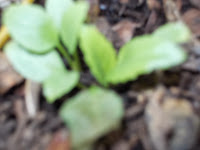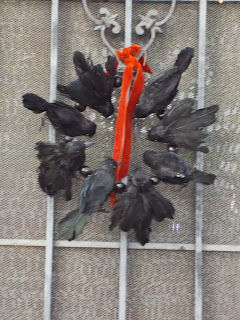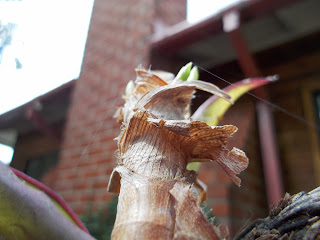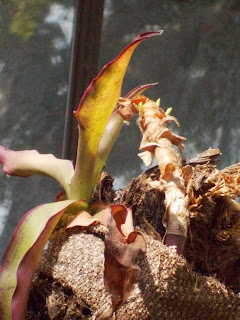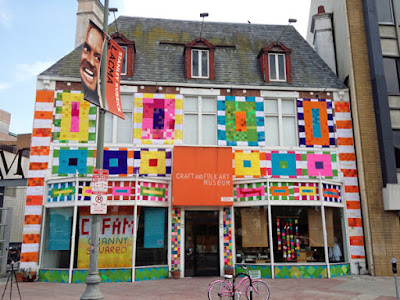In January 2012, I posted
cyathea mater epiphiticorum to describe how, during the previous November, I had started tying epiphitic plants to the trunk of a dead tree fern in our front garden. (Let's call the spurious tree "
CME" for short.) Then in March 2012 I posted
tree revision to celebrate the appearance of new growth on a cutting of basket plant (
Callisia fragrans) which topped the dead trunk.
Since that time, the pastiche of plants has had its good times and its bad times. Dead epidendrums have been taken down, while live ones have been admired. One tillandsia has not only survived but also multiplied and produced a spray of tiny blossoms -- purple with touches of yellow and white at the tip. I don't think the Spanish moss was alive when I tied it on, so after almost two years of denial I am admitting that I had essentially draped the tree with tattered crepe.
Today, citing the 13th-century hymns
Stabat Mater dolorosa (a Good Friday text) and
Stabat Mater speciosa (a Christmas text), I celebrate the fact that my secular foster-mothering tree still stands in spite of recent affronts to her dignity. The drooping Spanish moss would not be appropriate even if it were healthy. I think of how religious statues periodically receive festive new garments, and resolve that
CME shall wear a mantle of pale pink or white
basket-plant blooms and a skirt embroidered with
tiny orange or magenta orchids.
My faith in
CME's future is based on her survival after being badly battered while a new roof was being put on our house. On each of three long workdays beginning two weeks ago, huge plastic tarps were spread all around the house to catch a sequence of off-fallings: old shingles and wood, new foil-coated plywood scraps, sawdust, and trimmings from new shingles. At the end of each day, the tarps were removed and the whole area was cleaned with heavy-duty blowers.
Initially, I thought that our bromeliads, which I had been in process of transplanting (a story for another day), had suffered the most damage, but then I noticed that
CME's topmost tuft of basket plant was gone. Fortunately, I found this sprig of vegetation on the ground and stuck it back under a strip of the terrycloth toweling I had originally used to tie it to the tree.
Late yesterday afternoon, I decided to take some pictures of
CME so that I could post them with a description of the devastation. First, however, I used a fluffy duster to remove some of the sawdust that clung to the remaining leaves, and thus inadvertently knocked off the same leaves I had recently put back in place, and, adding insult to injury, broke off yet another section.
While replacing
CME's treetop once again, I was delighted to discover tiny new green leaves on the broken stem. This was a 'photo op' for sure, but it turned into a 'photo flop' because the sun had gone behind the house.
This morning, conditions for photography have been better, though I'm afraid a picture is not worth a thousand words when it must be explained to the viewer. From the perspective below, the basket plant's stem looks like the trunk of a palm tree, but in fact the assertive green buds at the top are less than a quarter inch in height. I like the way they stand out against our dark red soffit, however. The arching of the mature, red-tinged leaves contrasts nicely with the straight lines of chimney and roof, while patches of "blue skies up above" promise a fine summer day ahead.
Looking at
CME from the other side, against a backdrop of Chinese evergreen elms (the straight line is a downspout), we can see three tiny new buds along with a better shot of mature leaves, plus the speckled terrycloth along with the fibrous tree fern trunk at its very tip.
"Fall rains heal all," I wrote years ago to close a poem about getting through a dry and difficult year. In the meantime, frequent spraying and perhaps a foliar fertilizer should speed the process and let the new growth know how welcome it is in spite of fractured Latin and a barrage of building materials.



